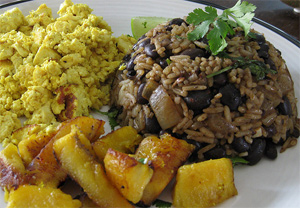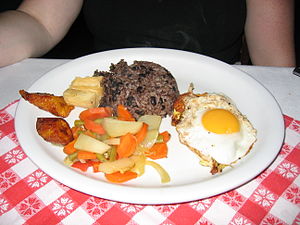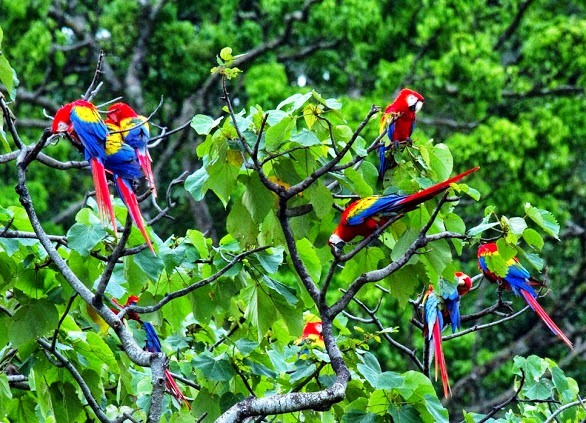In Costa Rica, gastronomy is an inheritance, and the result of the mixing of many races. Authentic Costa Rican food is made on wooden stoves and served on plantain leaves. Costa Rica is a country that stands out for its multicultural wealth, and although its population is a legacy of the mixing of races and of foreign influences and customs, Costa Rica has its own distinctive characteristics in both its everyday life and cooking. Each region has its own style or personal stamp, and even two regions sharing the same recipe will often do so under a different name or with a distinct cultural significance.
Owing to its climate and history, traditional Costa Rican cooking employs tropical fruits and vegetables in abundance, prepared in recipes that combine both native and European influence.
The basic elements of the Costa Rican diet are local agricultural products such as rice, beans, vegetables, fruits, dairy, many types of meat, and native recipes prepared using a corn base.
The habitual accompaniment of meat is generally corn tortillas, potatoes, or yucca.
The traditional breakfast is gallo pinto, which is a combination of rice and black beans, accompanied by corn tortillas, eggs, and sour cream.
Costa Rica’s most traditional dish is probably the “Casado”, which consists of rice, beans, fried plantains, and salad, accompanied by chicken, fish, beef, or pork.
The most traditional desserts are: pineapple or chiverre empanadas, (chiverre is a fruit native to Costa Rica, which is made into a fibrous honey to use in empanadas, most notably during Costa Rica’s Holy Week), arroz con leche (a rice pudding), coconut cajetas (a soft sweet candy made with sweetened condensed milk), and flan. Among traditional drinks, coffee takes first place, as Costa Rica produces one of the finest coffees in the world. Other tasty and healthy refreshments include tamarind juice and batidos (shakes), which are also called tropical fruit drinks.
There is also Horchata, which Costa Ricans make with boiled rice, roasted peanuts, milk, and water, flavored with cinnamon, rum, sugar, cocoa and vanilla.
Among indigenous alcoholic drinks is Chicheme, of native origin, prepared with corn, ginger, and brown sugar that is left to ferment. The Chinchiví is made with the juice of the sugar cane. El Vino de Coyol is the fermented sap of the coyol palm. All Costa Rican families enjoy Rompope (a type of eggnog), made using milk, cream, vanilla, and spirits, and of course you can find Imperial brand beer in all corners of the country. Next, we will present to you some typical dishes of Our Land:
A traditional meal of our country is the “Casado”, whose name refers to the eternal “marriage” of its ingredients, which include white rice, beans, salad, picadillo (minced meat or chopped vegetables), and a type of meat such as chicken, beef, pork, or fish. It is accompanied with strips of fried plantain and complemented with a natural juice drink, which is a homemade drink made with fruit mixed with water and sugar.
Plantains are another one of the fundamental elements of Costa Rican family dishes. A plantain is a fruit similar to the banana, although larger, and which needs to be cooked before eaten. In Costa Rica, it is prepared in many ways, including being cooked, fried, or baked.
There are many options for preparing ceviche (raw fish marinated in lemon and garlic), and depending on the ingredients used, it may even receive a new name. If the basic recipe indicates that fish or seafood be included, seasoned with onion, lemon, and other spices, it can also be limited to only one of those, and the result will still be wonderful.
In Costa Rica, ceviche is prepared with chayote (a vegetable sometimes called a water squash, which is similar to both squash and zucchini), unripened plantain, pejibaye (also known as the peach palm, a large starchy fruit often boiled and eaten with mayonnaise in Costa Rica), fish, and shrimp.
Among Costa Rica’s traditional dishes, one that has well deserved popularity and acceptance, is the well known roasted tamale, which is made with corn and cooked in plantain leaves. Also found among the traditional plates are arroz con leche (a rice pudding), cajetas (soft, sweet candies made with sweetened condensed milk), chiverre empanadas, (chiverre is a fruit native to Costa Rica, which is made into a fibrous honey to use in empanadas, most notably during Costa Rica’s Holy Week), jelly filled empanadas, rosquillas (a ring shaped pastry which Costa Ricans often make more salty than sweet), bizcochos (a ring shaped pastry similar to rosquillas that are typically sweet rather than salty), and tanelas (a sweet and salty bread from the Guanacaste region, which are made with a corn base and cooked in an earthenware oven).
Sour cream and cheese are products that are made from the fat content found in milk and a controlled fermentation process by means of lactic culture inoculation. Homemade sour cream is currently produced on small farms with a high grade of fat, while more commercial sour cream is produced in dairy plants. Sour cream and cheese are used to accompany bread, tortillas, pastries, gallo pinto (a traditional breakfast staple made of rice and black beans), and many other things.
Corn is a food that has been used since the pre-Columbian civilizations of Mesoamerica. In order to grind corn, the indigenous people used various instruments that they designed using material such as volcanic rock, to make metates (flat stones used for grinding corn), metlapil (stone rolling pin), and molcajetes (mortars). People were accustomed to cooking shelled corn with water and ash in pots above the fireplace, in order to later grind and prepare it.
Among the traditional drinks are agua dulce (prepared with hot water and a hardened brown sugar called dulce de tapa), agüesapo (agua dulce with lemon and guaro, which is Costa Rica’s sugar cane liquor), resbaladera (made with rice and stewed barley), horchata (made with rice, sugar, and cinnamon), tamarind juice, lemonade, Chicheme (an indigenous alcoholic drink), and coffee. However, the national drink par excellence is “fresco”, which is made of nearly any type of fruit mixed with water and sugar.









